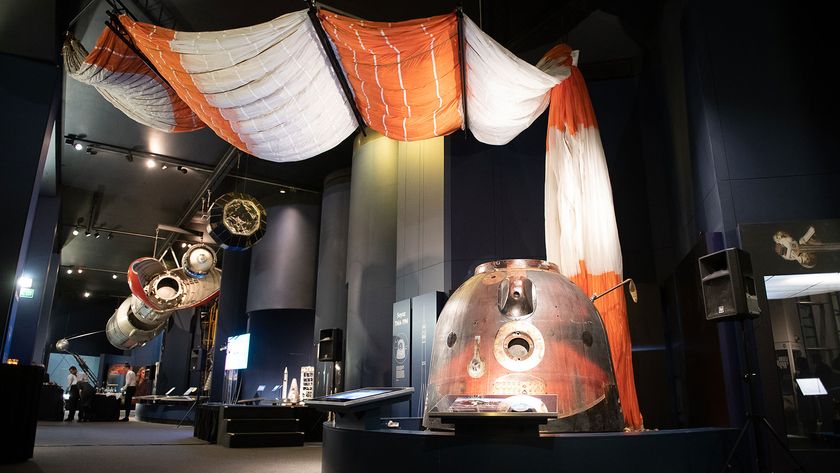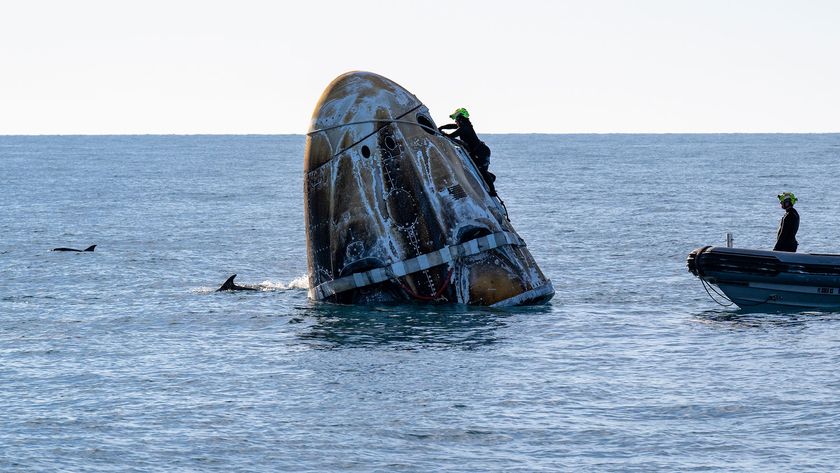Warp Speed Will Kill You
Captain Kirk might want to avoid taking the starship Enterprise to warp speed, unless he's ready to shrug off interstellar hydrogen atoms thatwould deliver a lethal radiation blast to both ship and crew.
There are just two hydrogen atoms per cubic centimeter onaverage in space, which poses no threat to spaceships traveling at low speeds.But those same lone atoms would transform into deadly galactic space mines fora spaceship that runs into them at near-lightspeed, according to calculations based on Einstein's special theory ofrelativity.
The original crew of "Star Trek" featured asunfortunate examples at a presentation by William Edelstein, a physicist at Johns Hopkins University, at the American Physical Society conference in Washington, D.C. on Feb. 13. The physicist showed a video clip of Kirk telling engineer Scotty to go towarpspeed.
"Well, they're all dead," Edelstein recalled saying.His words caused a stir among the audience.
Edelstein's personal interest in this thought experimentbegan 20 years ago, when his son Arthur asked him if there was friction inspace. The father responded that yes, there would be hydrogen bumping off aspaceship. But he soon realized that the stray atoms of hydrogen gas wouldactually go right through the ship traveling close to light speed, andirradiate both crew and electronics in the process.
More recently, the physicist and his now-grown soncalculated the scenario of a spaceship trying to travel halfway across ourMilky Way galaxy in just 10 years. That's doable in theory, because specialrelativity states that time slows down and distances shrink for travelersapproaching light speed.
Edelstein's work showed that a starship traveling at just99 percent of the speed of light would get a radiation dose from hydrogen of 61sieverts per second, when just one tenth of that number of sieverts woulddeliver a fatal dose for humans. And that's not even the 99.999998 percent oflight-speed necessary to make the journey to the center of the Milky Way in 10years
Get the Space.com Newsletter
Breaking space news, the latest updates on rocket launches, skywatching events and more!
At the higher speed, the human crew of a starship wouldexperience something like getting struck by the high-energy proton beam fromthe LargeHadron Collider particle accelerator at CERN in Geneva, Switzerland. On topof killing the crew, such powerful levels of energy would also likely destroy thestarship electronics.
"I'm not claiming this is a brilliant new discoveryor anything," Edelstein told SPACE.com. "I'm just saying that it'sinteresting."
Some audience members at the American Physical Society eventprotested that Kirk, Spock and the "StarTrek" crew would all still live because of the starship Enterprise having shields. But Edelstein noted some of the existing difficulties withcreating an electromagnetic shield with any resemblance to "StarTrek" technology.
Solid shields seem even more hopeless. A starship mightneed anywhere from a 4.4 -meter to 4,400-meter thickness of lead shielding todeflect the hydrogen radiation ? added mass that would make travel atnear-light speed even more impractical.
The physicist concluded by suggesting thatextraterrestrials might not have visited Earth because of all the problems intraveling at near-light speeds, including how to deal with deadly hydrogenspace mines. But for the record, he does believe that alien life exists.
"Getting between stars is a huge problem unless wethink of something really, really different," Edelstein said. "I'mnot saying that we know everything and that it's impossible. I'm saying it'skind of impossible based on what we know right now."
- Video - Star Trek's Warp Drive: Are We There Yet?
- Video: Can We Time Travel?
- Top 10 Star Trek Technologies
Join our Space Forums to keep talking space on the latest missions, night sky and more! And if you have a news tip, correction or comment, let us know at: community@space.com.
Jeremy Hsu is science writer based in New York City whose work has appeared in Scientific American, Discovery Magazine, Backchannel, Wired.com and IEEE Spectrum, among others. He joined the Space.com and Live Science teams in 2010 as a Senior Writer and is currently the Editor-in-Chief of Indicate Media. Jeremy studied history and sociology of science at the University of Pennsylvania, and earned a master's degree in journalism from the NYU Science, Health and Environmental Reporting Program. You can find Jeremy's latest project on Twitter.












